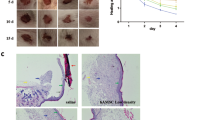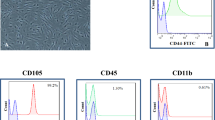Abstract
Wound healing is a highly orchestrated physiological process consisting of a complex events, and scarless wound healing is highly desired for the development and application in clinical medicine. Recently, we have demonstrated that human amniotic epithelial cells (hAECs) promoted wound healing and inhibited scar formation through a paracrine mechanism. However, exosomes (Exo) are one of the most important paracrine factors. Whether exosomes derived from human amniotic epithelial cells (hAECs-Exo) have positive effects on scarless wound healing have not been reported yet. In this study, we examined the role of hAECs-Exo on wound healing in a rat model. We found that hAECs, which exhibit characteristics of both embryonic and mesenchymal stem cells, have the potential to differentiate into all three germ layers. hAECs-Exo ranged from 50 to 150 nm in diameter, and positive for exosomal markers CD9, CD63, CD81, Alix, TSG101 and HLA-G. Internalization of hAECs-Exo promoted the migration and proliferation of fibroblasts. Moreover, the deposition of extracellular matrix (ECM) were partly abolished by the treatment of high concentration of hAECs-Exo (100 μg/mL), which may be through stimulating the expression of matrix metalloproteinase-1 (MMP-1). In vivo animal experiments showed that hAECs-Exo improved the skin wound healing with well-organized collagen fibers. Taken together, These findings represent that hAECs-Exo can be used as a novel hope in cell-free therapy for scarless wound healing.







Similar content being viewed by others
Abbreviations
- hAECs:
-
Human amniotic epithelial cells
- Exo:
-
Exosomes
- ECM:
-
Extracellular matrice
- MMP-1:
-
Matrix metalloproteinase-1
- MSCs:
-
Mesenchymal stem cells
- SEM:
-
Scanning electron microscopy
- BSA:
-
Bovine serum albumin
- DAPI4′:
-
6-diamidino-2-phenylindole
References
Berardis S, Dwisthi Sattwika P, Najimi M, Sokal EM (2015) Use of mesenchymal stem cells to treat liver fibrosis: current situation and future prospects. World J Gastroenterol 21:742–758. doi:10.3748/wjg.v21.i3.742
Buck AH et al. (2014) Exosomes secreted by nematode parasites transfer small RNAs to mammalian cells and modulate innate immunity. Nat Commun 5:5488. doi:10.1038/ncomms6488
Chen L, Tredget EE, Wu PY, Wu Y (2008) Paracrine factors of mesenchymal stem cells recruit macrophages and endothelial lineage cells and enhance wound healing. PloS ONE 3:e1886. doi:10.1371/journal.pone.0001886
Fang S et al. (2016) Umbilical cord-derived mesenchymal stem cell-derived exosomal MicroRNAs suppress myofibroblast differentiation by inhibiting the transforming growth factor-beta/SMAD2 pathway during wound healing. Stem Cells Transl Med 5:1425–1439. doi:10.5966/sctm.2015-0367
Fong CY, Biswas A, Subramanian A, Srinivasan A, Choolani M, Bongso A (2014) Human keloid cell characterization and inhibition of growth with human Wharton’s jelly stem cell extracts. J Cell Biochem 115:826–838. doi:10.1002/jcb.24724
Gurtner GC, Werner S, Barrandon Y, Longaker MT (2008) Wound repair and regeneration. Nature 453:314–321. doi:10.1038/nature07039
Hassan WU, Greiser U, Wang W (2014) Role of adipose-derived stem cells in wound healing. Wound Repair Regen 22:313–325. doi:10.1111/wrr.12173
Hu L et al. (2016) Exosomes derived from human adipose mensenchymal stem cells accelerates cutaneous wound healing via optimizing the characteristics of fibroblasts. Scientific reports 6:32993. doi:10.1038/srep32993
Khan M et al. (2015) Embryonic stem cell-derived exosomes promote endogenous repair mechanisms and enhance cardiac function following myocardial infarction. Circ Res 117:52–64. doi:10.1161/circresaha.117.305990
Lai RC et al. (2010) Exosome secreted by MSC reduces myocardial ischemia/reperfusion injury. Stem Cell Res 4:214–222. doi:10.1016/j.scr.2009.12.003
Li J et al. (2013a) Exosomes mediate the cell-to-cell transmission of IFN-alpha-induced antiviral activity. Nat Immunol 14:793–803. doi:10.1038/ni.2647
Li T et al. (2013b) Exosomes derived from human umbilical cord mesenchymal stem cells alleviate liver fibrosis. Stem Cells Dev 22:845–854. doi:10.1089/scd.2012.0395
Liang X, Ding Y, Zhang Y, Tse HF, Lian Q (2014) Paracrine mechanisms of mesenchymal stem cell-based therapy: current status and perspectives. Cell Transplant 23:1045–1059. doi:10.3727/096368913x667709
Liu J et al. (2012) Wnt/beta-catenin pathway forms a negative feedback loop during TGF-beta1 induced human normal skin fibroblast-to-myofibroblast transition. J Dermatol Sci 65:38–49. doi:10.1016/j.jdermsci.2011.09.012
Lo Cicero A et al. (2015) Exosomes released by keratinocytes modulate melanocyte pigmentation. Nat Commun 6:7506. doi:10.1038/ncomms8506
Lv LL et al (2013) Isolation and quantification of microRNAs from urinary exosomes/microvesicles for biomarker discovery. Int J Biol Sci 9:1021–1031. doi:10.7150/ijbs.6100
Nabai L, Kilani RT, Aminuddin F, Li Y, Ghahary A (2015) Methotrexate modulates the expression of MMP-1 and type 1 collagen in dermal fibroblast. Mol Cell Biochem 409:213–224. doi:10.1007/s11010-015-2526-8
Ruiss R, Ohno S, Steer B, Zeidler R, Adler H (2012) Murine gammaherpesvirus 68 glycoprotein 150 does not contribute to latency amplification in vivo. Virol J 9:107. doi:10.1186/1743-422x-9-107
Shu C, Smith SM, Melrose J (2016) The heparan sulphate deficient Hspg2 exon 3 null mouse displays reduced deposition of TGF-beta1 in skin compared to C57BL/6 wild type mice. J Mol Histol 47:365–374. doi:10.1007/s10735-016-9677-0
Sideek MA, Teia A, Kopecki Z, Cowin AJ, Gibson MA (2016) Co-localization of LTBP-2 with FGF-2 in fibrotic human keloid and hypertrophic scar. J Mol Histol 47:35–45. doi:10.1007/s10735-015-9645-0
Squadrito ML et al. (2014) Endogenous RNAs modulate microRNA sorting to exosomes and transfer to acceptor cells. Cell Rep 8:1432–1446. doi:10.1016/j.celrep.2014.07.035
Tan JL et al. (2015) Amnion cell-mediated immune modulation following bleomycin challenge: controlling the regulatory T cell response. Stem Cell Res Ther 6:8. doi:10.1186/scrt542
Usunier B, Benderitter M, Tamarat R, Chapel A (2014) Management of fibrosis: the mesenchymal stromal cells breakthrough. Stem Cells Int 2014:340257. doi:10.1155/2014/340257
Vader P, Mol EA, Pasterkamp G, Schiffelers RM (2016) Extracellular vesicles for drug delivery. Adv Drug Deliv Rev 106:148–156. doi:10.1016/j.addr.2016.02.006
Valadi H, Ekstrom K, Bossios A, Sjostrand M, Lee JJ, Lotvall JO (2007) Exosome-mediated transfer of mRNAs and microRNAs is a novel mechanism of genetic exchange between cells. Nat Cell Biol 9:654–659 doi:10.1038/ncb1596
van der Veer WM, Bloemen MC, Ulrich MM, Molema G, van Zuijlen PP, Middelkoop E, Niessen FB (2009) Potential cellular and molecular causes of hypertrophic scar formation. Burns 35:15–29 doi:10.1016/j.burns.2008.06.020
Vlassov AV, Magdaleno S, Setterquist R, Conrad R (2012) Exosomes: current knowledge of their composition, biological functions, and diagnostic and therapeutic potentials. Biochim Biophys Acta 1820:940–948. doi:10.1016/j.bbagen.2012.03.017
Wynn TA (2007) Common and unique mechanisms regulate fibrosis in various fibroproliferative diseases. J Clin Investig 117:524–529. doi:10.1172/jci31487
Yang T et al (2015) Exosome delivered anticancer drugs across the blood-brain barrier for brain cancer therapy in Danio rerio. Pharm Res 32:2003–2014. doi:10.1007/s11095-014-1593-y
Zhang HG, Grizzle WE (2014) Exosomes: a novel pathway of local and distant intercellular communication that facilitates the growth and metastasis of neoplastic lesions. Am J Pathol 184:28–41. doi:10.1016/j.ajpath.2013.09.027
Zhang B et al. (2015a) HucMSC-exosome mediated-Wnt4 signaling is required for cutaneous wound healing. Stem Cells 33:2158–2168. doi:10.1002/stem.1771
Zhang J et al. (2015b) Exosomes released from human induced pluripotent stem cells-derived MSCs facilitate cutaneous wound healing by promoting collagen synthesis and angiogenesis. J Transl Med 13:49. doi:10.1186/s12967-015-0417-0
Zhao Y et al. (2015) Exosomes derived from human umbilical cord mesenchymal stem cells relieve acute myocardial ischemic injury. Stem Cells Int 2015:761643. doi:10.1155/2015/761643
Zhao B et al (2016a) Human amniotic epithelial cells attenuate TGF-beta1-induced human dermal fibroblast transformation to myofibroblasts via TGF-beta1/Smad3 pathway. CytoTherapy 18:1012–1024. doi:10.1016/j.jcyt.2016.04.009
Zhao B et al. (2016b) Human amniotic epithelial stem cells promote wound healing by facilitating migration and proliferation of keratinocytes via ERK, JNK and AKT signaling pathways. Cell Tissue Res 365:85–99. doi:10.1007/s00441-016-2366-1
Zomer A et al (2015) In Vivo imaging reveals extracellular vesicle-mediated phenocopying of metastatic behavior. Cell 161:1046–1057. doi:10.1016/j.cell.2015.04.042
Acknowledgements
This work was supported by the National Health and Family Planning Commission of China (2015SQ00060) and National Natural Science Foundation of China (81201470).
Author information
Authors and Affiliations
Corresponding authors
Ethics declarations
Competing interests
The authors declare no conflict of interest.
Additional information
Bin Zhao, Yijie Zhang, Shichao Han have contributed equally to this work.
Rights and permissions
About this article
Cite this article
Zhao, B., Zhang, Y., Han, S. et al. Exosomes derived from human amniotic epithelial cells accelerate wound healing and inhibit scar formation. J Mol Hist 48, 121–132 (2017). https://doi.org/10.1007/s10735-017-9711-x
Received:
Accepted:
Published:
Issue Date:
DOI: https://doi.org/10.1007/s10735-017-9711-x




